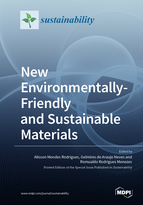New Environmentally-Friendly and Sustainable Materials
A special issue of Sustainability (ISSN 2071-1050). This special issue belongs to the section "Sustainable Materials".
Deadline for manuscript submissions: closed (5 November 2021) | Viewed by 14938
Special Issue Editors
Interests: glasses; glass-ceramics, solid wastes; clays, crystallization, sustainable materials, eco-friendly materials, biomaterials
Interests: processing of ceramic materials; nonmetallic materials; extraction and transformation of materials; ceramic materials; environmental; development of new materials; durability and recycling of solid waste
Special Issues, Collections and Topics in MDPI journals
Interests: ceramic materials; microwave synthesis and processing; solid waste recycling; nanotechnology; ultrafast sintering; drilling fluids; biomaterials and water treatment
Special Issues, Collections and Topics in MDPI journals
Special Issue Information
Dear Colleagues,
One of the great challenges of contemporary society is establishing a sustainable way of life in harmony with the environment without compromising economic growth and technological development. On the other hand, the increase in the world population has driven per capita consumption, and consequently, the generation of waste. Because of this, new materials are being developed from different types of waste.
This Special Issue aims to highlight and share recent scientific findings in the area of “New Environmentally Friendly and Sustainable Materials” manufactured from different material types (polymers, ceramics, metallics, and composites) and urban, industrial, mining and agricultural wastes. Moreover, scientific topics such as improving performance and durability, materials characterization, hybrid materials, foams and porous materials, trends and advances, and mechanical, electrical, magnetic, optical, and thermal properties will also be accepted.
We kindly invite you to submit a manuscript(s) for this Special Issue. Full papers, communications, and reviews are all welcome.
Prof. Dr. Alisson Mendes Rodrigues
Prof. Dr. Gelmires de Araujo Neves
Prof. Dr. Romualdo Rodrigues Menezes
Guest Editors
Manuscript Submission Information
Manuscripts should be submitted online at www.mdpi.com by registering and logging in to this website. Once you are registered, click here to go to the submission form. Manuscripts can be submitted until the deadline. All submissions that pass pre-check are peer-reviewed. Accepted papers will be published continuously in the journal (as soon as accepted) and will be listed together on the special issue website. Research articles, review articles as well as short communications are invited. For planned papers, a title and short abstract (about 100 words) can be sent to the Editorial Office for announcement on this website.
Submitted manuscripts should not have been published previously, nor be under consideration for publication elsewhere (except conference proceedings papers). All manuscripts are thoroughly refereed through a single-blind peer-review process. A guide for authors and other relevant information for submission of manuscripts is available on the Instructions for Authors page. Sustainability is an international peer-reviewed open access semimonthly journal published by MDPI.
Please visit the Instructions for Authors page before submitting a manuscript. The Article Processing Charge (APC) for publication in this open access journal is 2400 CHF (Swiss Francs). Submitted papers should be well formatted and use good English. Authors may use MDPI's English editing service prior to publication or during author revisions.
Keywords
- materials (ceramics, polymers, metals, and composites)
- sustainable materials
- solid wastes
- glass and glass-ceramics foams
- process optimization
- wastes valorization
- materials for construction
- recycling
- green manufacturing








